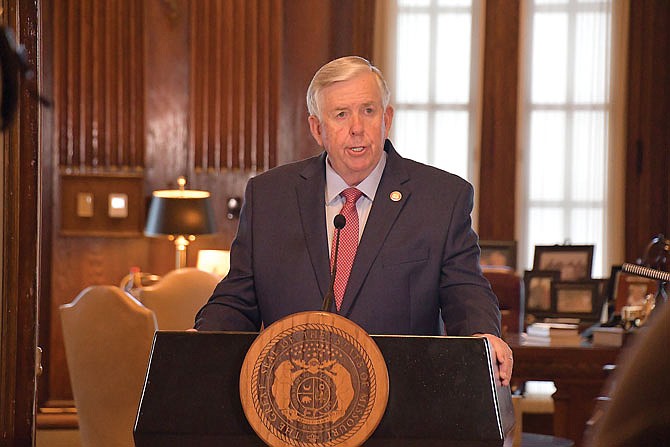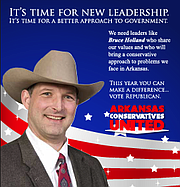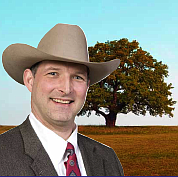This article is free to all readers because it includes information important to public safety and health in our community.
Missourians must take it upon themselves to act in ways about coronavirus that protect the health care systems everyone depends on, Gov. Mike Parson said Thursday.
Parson did not issue any statewide public health mandates - against the urging of state medical associations - but he did issue a new public health warning and guidance "to set expectations for all individuals living and/or working in Missouri and for our local jurisdictions."
The governor on Thursday extended Missouri's current state of emergency for the COVID-19 pandemic through March 31, 2021.
"The hospital capacity is becoming a problem," especially staffing, he said, and coronavirus cases are skyrocketing in the state.
There were more new COVID-19 cases in Missouri during October than all the previous months of the pandemic so far combined, and more cases in just the first 15 days of November than in all of October, Parson said.
The most recent White House Coronavirus Task Force report this week found 97 percent of all Missouri counties had critically high, red zone levels of the rate of new cases and positive lab test results - all of the state's 114 counties but three.
Though Parson remained adamant that Missourians should have a voice through local authorities and have a choice in how they protect themselves, the governor did say Thursday he would communicate to counties and mayors across the state a public health warning and guidance.
"We're going to encourage them to take some sort of action" to curb the rising count of infections, Parson said.
That warning and guidance says that until a vaccine is widely available to the general public, "the most effective weapon against COVID-19 remains prevention. We do not need to lockdown our communities if people do the right things to fight the spread of the virus."
It's advised that everyone able should wear a mask at all times in public and other settings outside their homes where social distancing is not possible; maintain social distancing of at least 6 feet; limit close contact with people to less than 15 minutes; wash hands multiple times a day; stay home when sick; and limit regular interactions to a small group (fewer than 1o) of family members, friends or coworkers if living in a county with high case and test positivity rates.
The new guidance Thursday gave three categories for counties and suggested action plans for local authorities:
Category 1 counties are at "extreme risk" - those with a seven-day positivity rate of 15 percent or more, using the Centers for Disease Control and Prevention's metric, and a seven-day case rate per 100,000 residents of 350 or more, as listed on the state's online COVID-19 dashboard.
Such counties include Cole County, which as of Thursday afternoon had a seven-day positivity rate of 29.1 percent and a seven-day case rate of 919.9 per 100,000 people - the second-highest in the state, behind Henry County.
It's recommended that such counties limit occupancy inside businesses to reflect social distancing, limit planned or spontaneous social gatherings to 10 people or fewer, and "strongly" advise masks be worn in all offices and businesses where social distancing is not possible.
Social gatherings do not include "normal business activities, religious services, schools and school activities, and extended family gatherings."
Category 2 counties are at "critical risk" - those with a seven-day positivity rate of 10-14 percent and a seven-day case rate of 100-349 per 100,000 people.
Such counties are recommended to limit occupancy inside businesses to reflect social distancing, limit social gatherings to 25 people or fewer, and advise that masks be worn in offices and businesses with 10 or more people and social distancing is not possible.
Category 3 counties are at "serious risk" - those with a seven-day positivity rate of 5-9 percent and a seven-day case rate of 10-99 per 100,000 people.
Such counties do not need limits on business occupancy but should limit social gatherings so as to maintain 6 feet of social distancing between people and should advise the same mask-wearing practices as Category 2 counties.
"Local communities can establish higher, more stringent standards above the state's public health advisory baseline," and the baseline provides a statewide set of standards, according to the guidance.
The full public health warning and guidance is available at health.mo.gov/living/healthcondiseases/communicable/novel-coronavirus/pdf/advisory-20201119.pdf.
Communities can move down in risk category after showing two consecutive weeks of meeting the lower category's criteria.
"I do truly believe in local control, and will continue to support the decisions that they make," Parson said of the work of city councils, mayors and county commissioners. "If everybody would really just take it upon themselves - the next four to six weeks, I think, are critical to try to change this."
"We're going to have to do everything we can" to curb the mounting strain the pandemic is placing on hospitals and their staff, he added.
As of Nov. 15 - the most recent metrics for hospitalizations on the state's online COVID-19 dashboard - 31 percent of Missouri's intensive care beds remained open, but that figure varies by region, with 32 percent of ICU beds available in the central region, 22 percent in the northwest part of the state, 18 percent in and around Kansas City, and 11 percent in the northeast.
"Staffing is the major issue - not so much bed space, but the reality of having people to work at those hospitals," Parson said.
He said his administration is looking at "all options" to support hospital staffing, including using the military or bringing in health care workers from other states.
While he praised the commitment of health care workers to their patients, Parson said overwhelmed hospitals threaten people's care - not just those with COVID-19, but people who get into car crashes or are dealing with other serious health issues.
"It will put a stress on the systems if we don't change the behavior of how we conduct ourselves," he said.
"Everybody wants so badly to go back to 'a normal life,' but we're not going to be able to do that, not for several months," Parson told Missourians.
Even if all Missourians immediately heed his call, cases and hospitalizations will continue to increase for weeks, given the lag between infection and symptoms - if any - or more serious complications developing.
"The virus is on the rise, so even if (new cases) get to a plateau, what follows is that hospitalization," Parson said.
Parson's extension of the state of emergency - which Missouri will have been under for more than a year by the time it ends March 31 - included keeping the Missouri National Guard activated to respond to the crisis, as well as continued temporary suspensions of regulations to support telemedicine and trucking and make easier health care licensing and teacher certification.
This article was updated at 3:35 p.m. Nov. 19, 2020, with additional details.



